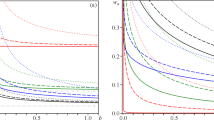Abstract
In this paper, the modified constrained volume model, which describes the evolution of anisotropy of immiscible polymer blends, composed of Newtonian components, was examined during shearing motion (steady and oscillatory) at various viscosity ratio values. We found that the linear correction to the rate of deformation tensor causes the droplet to change its volume at viscosity ratio values lower than unity, and to cause premature tumbling at viscosity ratio values larger than unity, in a case where retraction, breakup, and coalescence modules of the model were turned off. The use of Eshelby tensor, together with a closure to relate anisotropy to the Eshelby concentration tensor, mostly solved the problem. The model’s predictions are then shown at various capillary number values and at various viscosity ratio values. Comparison of model predictions to single droplet data at nonunity viscosity ratio value showed good agreement. Finally, model predictions of first normal stress difference during startup of steady shear are compared to experimental rheological results for immiscible polymer blends that are available in literature. Good predictions can be achieved by the introduction of a new switch function that controls the retraction and breakup modules. The model’s predictions at large amplitude oscillatory shear were examined. It was found that linear corrections to the velocity gradient tensor can be used for strains up to 100 %. For larger strain values, the Eshelby concentration tensor must be used.
















Similar content being viewed by others
References
Almusallam AS, Larson RG, Solomon MJ (2000) A constitutive model for the prediction of ellipsoidal droplet shapes and stresses in immiscible blends. J Rheol 44:1055–1083
Almusallam AS, Larson RG, Solomon MJ (2003) Anisotropy and breakup of extended droplets in immiscible blends. J Non-Newton Fluid Mech 113:29–48
Almusallam AS, Larson RG, Solomon MJ (2004) Comprehensive constitutive model for immiscible blends of Newtonian polymers. J Rheol 48:319–348
Batchelor GK (1970) The stress system in a suspension of force-free particles. J Fluid Mech 41:545–570
Chesters AK (1991) The modelling of coalescence processes in fluid-liquid dispersions: a review of current understanding. Trans IChemE 69:259–270
Choi SJ, Schowalter WR (1975) Rheological properties of nondilute suspensions of deformable particles. Phys Fluids 18:420–427
Comas-Cardona S, Tucker CL (2001) Measurements of droplet deformation in simple shear flow with zero interfacial tension. J Rheol 45:259–274
Cristini W, Hooper RW, Macosko CW (2002) A numerical and experimental investigation of lamellar blend morphologies. Ind Eng Chem Res 41:6305–6311
Doi M, Ohta T (1991) Dynamics and rheology of complex interfaces. I J Chem Phys 95:1242–1248
Edwards BJ, Dressler M (2003) A rheological model with constant approximate volume for immiscible blends of ellipsoidal droplets. Rheol Acta 42:326–337
Edwards BJ, Dressler M, Grmela M, Ait-Kadi A (2003) Rheological models with microstructural constraints. Rheol Acta 42:64–72
Elmendorp JJ (1986) A study on polymer blending microrheology. Polymer Eng Sci 26(6):418–425
Eshelby JD (1957) The determination of the elastic field of an ellipsoidal inclusion, and related problems. Proc Roy Soc (London) Ser A 241:376–396
Grace HP (1982) Dispersion phenomena in high viscosity immiscible fluid systems and application of static mixers as dispersion devices in such systems. Chem Eng Commun 14:225–277
Guido S, Minale M, Maffettone PL (2000) Drop shape dynamics under shear-flow reversal. J Rheol 44:1385
Jackson NE, Tucker CL (2003) A model for large deformation of an ellipsoidal droplet with interfacial tension. J Rheol 47:659–682
Lee HM, Park OO (1994) Rheology and dynamics of immiscible polymer blends. J Rheol 38(5):1405–1425
Maffettone PL, Minale M (1998) Equation of change for ellipsoidal drops in viscous flow. J Non-Newton Fluid Mech 78:227–241
Minale M (2010) Models for the deformation of a single ellipsoidal drop: a review. Rheol Acta 49:789–806
Peters GWM, Hansen S, Meijer MEH (2001) Constitutive modeling of dispersive mixtures. J Rheol 45:659–689
Stone HA, Bentley BJ, Leal LG (1986) An experimental study of transient effects in the breakup of viscous drops. J Fluid Mech 173:131–158
Tomotika S (1935) On the instability of a cylindrical thread of a viscous liquid surrounded by another viscous fluid. Proc Roy Soc (London) A150:322–337
Tucker CL, Moldenaers P (2002) Microstructural evolution in polymer blends. Annu Rev Fluid Mech 34:177–210
Vinckier I (1998) Microstructural analysis and rheology of immiscible polymer blends. Katholieke Universiteit Leuven, Leuven
Vinckier I, Moldenaers P, Mewis J (1996) Relationship between rheology and morphology of model blends in steady shear flow. J Rheol 40:613–631
Wetzel ED (1999) Modeling flow-induced microstructure in inhomogeneous liquid–liquid mixtures. University of Illinois, Urbana-Champaign
Wetzel ED, Tucker CL (1999) Area tensors for modeling microstructures during laminar liquid-liquid mixing. Int J Multiph Flow 25:35–61
Wetzel ED, Tucker CL (2001) Droplet deformation in dispersions with unequal viscosities and zero interfacial tension. J Fluid Mech 426:199–228
Yu W, Bousmina M (2003) Ellipsoidal model for droplet deformation in emulsions. J Rheol 47(4):1011–1039
Yu W, Zhou C (2007) A simple constitutive equation for immiscible blends. J Rheol 51:179–194
Acknowledgement
Financial support for this project was provided by a grant from Kuwait University (EC 01/10).
Author information
Authors and Affiliations
Corresponding author
Rights and permissions
About this article
Cite this article
Almusallam, A.S. The modified constrained volume model predictions in shearing flow at nonunity viscosity ratio values. Rheol Acta 52, 607–621 (2013). https://doi.org/10.1007/s00397-013-0692-8
Received:
Revised:
Accepted:
Published:
Issue Date:
DOI: https://doi.org/10.1007/s00397-013-0692-8



